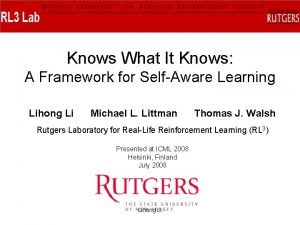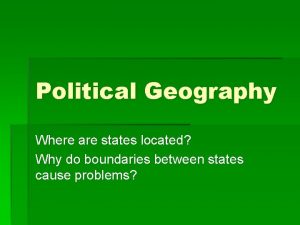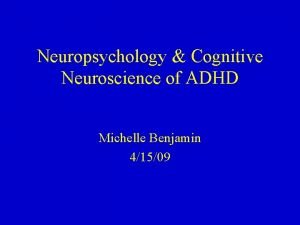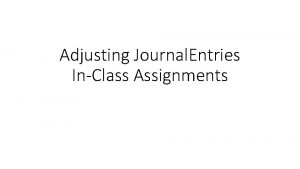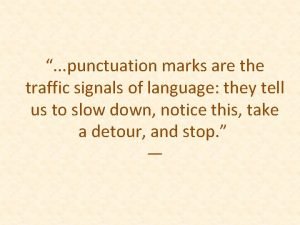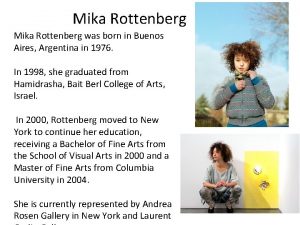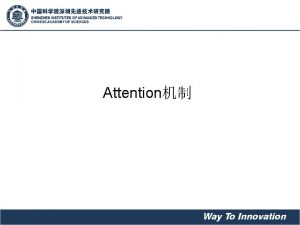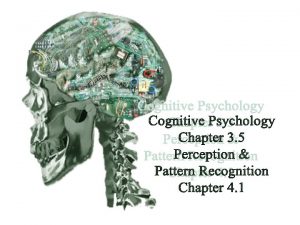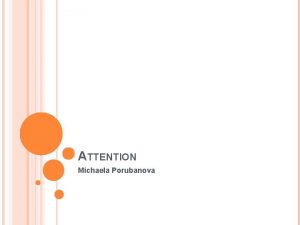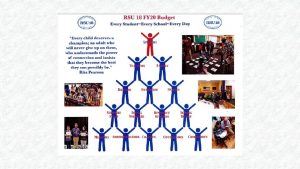Attention What Is Attention Every one knows what

































- Slides: 33

Attention

What Is Attention? • “Every one knows what attention is. It is the taking possession by the mind, in a clear and vivid form of one out of what seem several simultaneously possible objects or trains of thought. Focalization, concentration of consciousness are of its essence. It implies withdrawal from some things in order to deal with others…” (James, 1890, p. 403)

Attention is. . . • An attitude of mind • Relative proportion of activated traces to all memory traces – active workspace • Some form of energy or desire involving will or effort • A filter • An allocation of resources • A spotlight, a selective attenuator

Attention • is limited (we can only attend to a few things at a time) - RESOURCE • is selective (we can direct our attention to one thing ) SELECTIVE OR DIRECTED • is often linked to consciousness (what we are aware of at any given time) DUAL MODE PRINCIPLE

Characteristics • General agreement regarding two characteristics outlined by James: – Bottom up (sensory) attention driven by environmental events (stimulus-driven; exogenous) – Top down (volitional) attention to both external and internal stimuli (goal-driven; endogenous) • May be thought of as automatic vs. controlled, respectively.

Automatic Vs. Controlled Processing Distinction • Automatic processes – no capacity limitation; fast – do not require attention, effort – difficult to modify once learned • Controlled processes – limited in capacity; slow – require attentional resources, effort – can be used flexibly in changing circumstances

Functional Components of Attention What gains access to WM? Regulation of channel signal strength Automatic filtering for behavioral importance Knudsen, Ann Rev NSci, 2007

Purposes of Attention • • Cope with inherent capacity limitation of brain Facilitate stimulus detection Facilitate stimulus perception Facilitate thinking Facilitate memory Recruit relevant processors Prepare for action

Varieties of Attention • Focused attention (processing only one input at a time) – Orienting to sensory events – Detecting signals for focal (conscious) processing • Divided attention (processing multiple inputs according to nature of inputs and goals) • Maintaining a vigilant state

Varieties of Attention

Dimensions of Attention • Focality (detection vs. selective attention) • Duration (brief vs. sustained attention) • Input channel – Visual attention • Spatial • Object-based – Auditory attention • What, where • Cognitive effect (facilitation vs. inhibition)

Broadbent (1958) • Influential paper on focused (selective) attention; felt by many to be a critical ‘cornerstone’ paper in cognitive psychology • Influenced by Cherry’s shadowing results • Used dichotic listening, and found a strong tendency to report digits ‘by ear’, thus reflecting a tendency to select based on perceptual/physical characteristics of the input

Broadbent’s Filter Theory Stimulus #1 Stimulus #2 Limited capacity STM Sensory register/buffer Selection Filter

Problems With Broadbent’s Filter Model • Sometimes attention doesn’t follow input source: Gray & Wedderburn (1960) fan rage tic out tas ous • Can demonstrate that “unattended” information is processed phonologically or semantically: Corteen & Wood (1972) – EDR’s to shock-associated words in an unattended channel – city name study

Assessing Attention • Physiological Measures – Heart Rate – Pupil Diameter – Galvanic Skin Response • Behavioral Measure – Dual Task Paradigm

Dual Task Performance • Relevant to processing capacity • Interference methodology a useful tool to determine whether two tasks share resources • What determines degree of interference? – Task similarity – Task difficulty – Practice/expertise

• Sensitivity (d') to auditory and visual signals as a function of concurrent imagery modality (auditory vs. visual). Adapted from Segal and Fusella (1970).

Dual Task Paradigm: An example

Dual Task Paradigm

A Capacity Model Kahneman (1973) • Supplements previous bottom-up analysis with a consideration of topdown influences • Emphasizes concept of processing resources • Attention and mental effort are strongly correlated • Arousal can work to increase processing resources

Kahneman’s (1973) single resource model

Understanding the Effects of Attention is Important When there are Limitations on Processing • Resource-limited processes – Processes dependent on the availability of resources that can be devoted to task solution – Applying more effort or processing resources increases task performance • If output not available until task is finished, then devoting more resources decreases RT • If output continuously available, then performance level increases • Data-limited processes – Processes dependent upon the quality of data input, rather than upon resource allocation • Applying more resources may have little effect on performance • Most processes have both resource- and data-limited components

Kahneman’s model: Assumptions: • Attention = a set of cognitive processes (resources) for detecting, recognizing & categorizing stimuli • Different tasks require more or fewer of these cognitive resources • Multiple tasks can be performed unless their total requirements exceed the resources available • Available capacity depends on arousal • Allocation of resources is partially voluntary

Kahneman’s single resource model Rules govern how we allocate attention resources: 1. We allocate attention to ensure that we can complete PRIMARY activity 2. Enduring dispositions (involuntarily directs one’s attention -Novelty -Meaningfulness 3. Momentary intentions (self-directed) -Instructions

Wickens’ (1984) Multiple Resource Model

Attention: A Filter or bottleneck theories contend that people have difficulty doing several tasks at one time because: – Humans perform each human information process in serial order – Humans process only one piece of information at one time – Somewhere along the stage of information processing a bottleneck occurs – Bottleneck causes information to be filtered out


IP Model

Focused Visual Attention • The Attentional “Spotlight” model – items within a small portion of the field can be seen clearly – Posner’s ‘covert’ shifting of the spotlight – Problem: proximity not always facilitative –e. g. Driver & Baylis, 1989 – common movement • Zoom-lens model (Eriksen & Yeh, 1985) – – Magnification inversely proportional to FOV ‘magnification’ can be increased or decreased Grouping processes affect spatial extent of attention Problem: attention can be object-based; objects outside the zoom can be processed or even inhibited


Posner’s components of attention • Three components involved in visual attention: – Disengage attention from a given stimulus – Shift attention from one stimulus to another – Engage attention on a new stimulus

Norman & Shallice • Three levels of functioning: – Fully automatic processes, controlled by well-learned schemas – Partially automatic processing, controlled by contention scheduling – Deliberate control by a conscious, supervisory attentional system

Summary: Important Concepts • Limited-capacity for informationprocessing (information bottleneck) leads to selective attention • Attentional acts take time and effort • Attentional control re: goals and plans • Automatic vs. Controlled processing • Attention and consciousness
 Knows what it knows: a framework for self-aware learning
Knows what it knows: a framework for self-aware learning Where was canaan
Where was canaan Every nation and every country has
Every nation and every country has Empower every person and organization
Empower every person and organization Every knee shall bow every tongue confess
Every knee shall bow every tongue confess Every rotarian every year
Every rotarian every year Every nation and every country
Every nation and every country Every picture has a story and every story has a moment
Every picture has a story and every story has a moment Every child every day
Every child every day Michelle benjamin phd
Michelle benjamin phd One empire one god one emperor
One empire one god one emperor One one one little puppy run
One one one little puppy run One king one law one faith
One king one law one faith One empire one god one emperor
One empire one god one emperor One ford plan
One ford plan See one do one teach one
See one do one teach one See one, do one, teach one
See one, do one, teach one Night structure
Night structure Studiendekanat uni bonn
Studiendekanat uni bonn One vision one identity one community
One vision one identity one community Asean one vision one identity one community
Asean one vision one identity one community Molly mocha employs one college student every summer
Molly mocha employs one college student every summer Pta every child one voice
Pta every child one voice Every ten minutes one kind of animal
Every ten minutes one kind of animal Worldwide one person in every experiences persistent hunger
Worldwide one person in every experiences persistent hunger King jesus you're the name
King jesus you're the name Punctuation marks are like traffic signs. this sentence is
Punctuation marks are like traffic signs. this sentence is He that travels far knows much
He that travels far knows much A smart person knows what to say quote
A smart person knows what to say quote Nobody knows how to make a pencil
Nobody knows how to make a pencil The reader knows captain beatty is educated because he
The reader knows captain beatty is educated because he Thoughts and intents of the heart
Thoughts and intents of the heart God knows my thoughts
God knows my thoughts Mika rottenberg no nose knows
Mika rottenberg no nose knows
